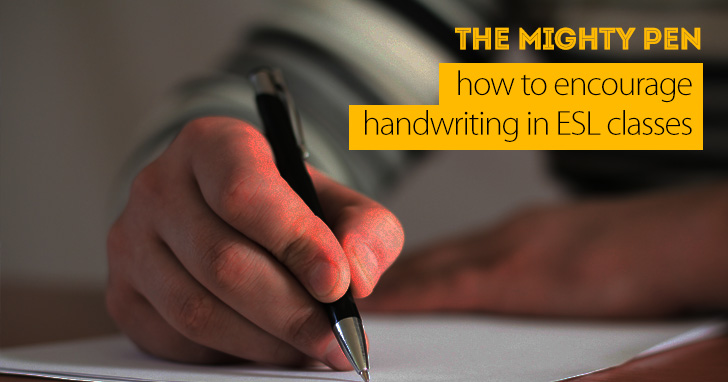7 Things Your Quiet ESL Students Are Not Telling You


For me, the debate is over, so I’m just going to vociferously encourage that you promote handwriting in your classroom.
This doesn’t mean that we’re anti-technology, though some of our students will definitely balk at the requirement to use pens.
I’ve been told that the use of a pen is, in no particular order: boring, difficult, impossible, awkward, useless, slow, meaningless, unhelpful and (congratulations to the student for this winning adjective) anachronistic.I’ve had prolonged arguments with students who’ve informed me that I’m a dinosaur, a throwback to pre-electronic times when rote learning and savage discipline were the norm.
Well, the very same arguments can be made about homework. Or exercise. Or practicing our other hard-won skills, like the piano, or karate, or jewelry making. I have the real feeling that, behind each complaint about the requirement to use a pen in my class lurks a soupçon of attention deficit, an unwillingness to do one thing slowly and at length. For me, handwriting is like eating your greens or getting up early to go for a run: it’s good for you, promises rewards far out of proportion to the effort invested, and you should be making a habit of it. End of story.
However, you’re going to get pushback, especially if you teach people born at the turn of the 21st century, so here are the classic student rationales for refusing to use a pen:
| The Complaint | The TeflGuy Response |
| It’s slow | Like anything else, it gets faster as you practice it. |
| It’s boring | There’s enormous pleasure to be found in the precise execution of something difficult. |
| It’s not modern | We’ve been writing for 5000 years. We’ve had Ipads since last week. You decide which is most culturally meaningful. |
| I can’t do it. | Practice it ever day. Think about it - you couldn’t type until you’d practised it for years. |
| My pen might break. | Your laptop might die. |
| I can’t read my own writing. | Slow down, practice daily, and focus like crazy. |
| I’ll lose my notebook but I won’t lose my laptop. | Anything can be kept safe if you’re careful. Besides, a mugger doesn’t care about your notebook. |
| I can’t listen and write at the same time | But you can listen and type at the same time? Just practice, you’ll be fine. |
And so on, and so on. I encourage you to have this debate with your students early on in the process, be your most persuasive self, and then reward consistent handwriting practice and indications of progress. In the end, you’re advocating not for handwriting to supplant typing once more, but to develop in parallel with it, as a skill of equal importance.

This could be a maxim for the 21st century, a ‘Keep Calm and Carry On’ for modern times. Letter formation requires real focus; an inability to do so is one of the first indications of latent attention problems. I’m living proof.
Handwriting it all well and good, but you need to be able to decipher the ‘message to your future self’ which note-taking creates. Go back to focusing on individual letter formation and perhaps switch from cursive to printing if that’s clearer.
Remind your students that Chinese kids (to name one example) repeat the writing and pronunciation of pictograms until they can reproduce each one with unerring precision. While you’re there, draw a line of causation between the phenomenal memory abilities of many east Asian students (I’m stereotyping, but you take my point) and the careful, repetitive actions required to learn their own language.
Most students who have poor handwriting have problems keeping it level. Remind your students of the importance of staying on the line, and reward those who struggle to achieve this; for some people, it is far from easy.
Worthwhile skills are gained by consistent practice, and in literally no other way. We all wish we could wave a wand or rub a crystal, or receive a cerebral implant like Neo in The Matrix, but sadly, we can’t.
Encourage your students to keep a journal, adding a paragraph (or two, or three) about each day before they go to sleep. There’s an unexpected benefit to this; psychologists report that people who take a moment each night to reflect on three positive parts of their day soon become happier and more motivated.
As you monitor your students work, during a pair or group activity, for example, cast an eye over their notebooks and make sure they follow an old but relevant maxim.
If it goes on the board, it should go in your book
In addition, make sure they have written the date, a topic or title for the lesson, and details on homework; this last one avoids any confusion or claims that they didn’t realize the homework was due.
Neither are a replacement for well-formed words (in complete sentences), but notebooks become a much more attractive and engaging place when the students spice them up with drawings, color highlighting, diagrams, etc. Color is especially useful for drawing attention to grammar points, special exceptions, and issues to be researched later.
More recently, with the wholesale (and, for me, seriously misguided) de-emphasizing of handwriting in schools across the world, we’re going to need both responses to students who object to a ‘pen-only’ environment, and tactics for ensuring that they practice well and regularly. The debate is over; we need to provide a circumstance in which our students will use pens, because as devices become ubiquitous, the classroom might become the only place where they do so.